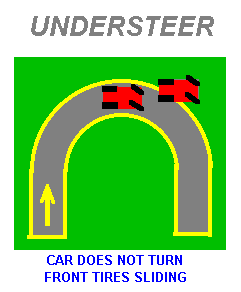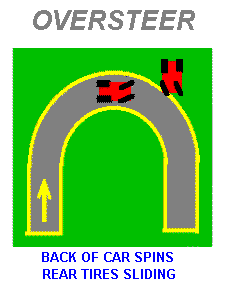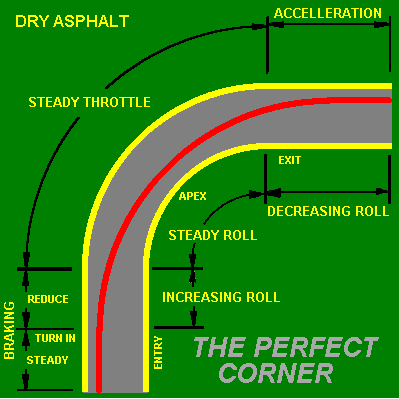FRONT-WHEEL-DRIVE: BITING THE HAND THAT DRIVES IT
by John Lee

Rescue those being led away to death; hold back those staggering toward slaughter. --Proverbs 24:11 [Recovery Devotional Bible]
More front-wheel-drive vehicles crash every year than all other vehicles combined (mainly because there are more of them on the road). Front-wheel-drive is marketed by automakers as the greatest invention since the internal combustion engine. I bet you have never heard anything bad about it, have you?
It is not easy to find reference to front-wheel-drive vehicles in books about performance driving techniques. In his book Winning -- A Race Driver's Handbook, George A. Anderson writes that he chooses not to discuss it in his book, since "front-wheel-drive is a totally inappropriate configuration for a car that is to be driven fast." Mr. Anderson is the chief instructor for Land'O Lakes Driver School at Brainerd International Raceway in Minnesota. However, "fast" is a relative term, and the drivers of passenger vehicles can quickly lose control at speeds as low as 30 miles per hour, and can certainly lose control at typical highway speeds -- and millions of drivers do. As mentioned previously, vehicle crashes are a primary source of DWI arrests, so learning how to avoid preventable crashes can be an effective protection from criminal prosecution by the government.
Vehicles that propel themselves with their rear wheels tend to have less traction in slippery low speed conditions. As a car salesman, this was one of the chief complaints that I heard from some customers; perhaps they had trouble pulling out of their driveways on a wet or snowy day. Of course, front-wheel-drive cars also spin their wheels under the same conditions, and rear-wheel-drive vehicles can gain traction by simply adding ballast weight to the rear luggage compartment. However, rear-wheel-drive vehicles have a natural stability in emergency situations. That's why all thoroughbred race cars are rear-wheel-drive, even ones that are built to resemble front-wheel-drive "factory" cars, as seen in so-called stock car racing today.
Production-based "sports car" racing requires race drivers to compete in modified factory built cars, many of which are front-wheel-drive. These drivers have learned how to overcome the built-in instability of front-wheel-drive. The government did not teach them this knowledge. They gained it on their own, often from attending a performance driving school using front-wheel-drive cars.
What do race car driving skills have to do with a driver who does not exceed the speed limit? When would such skills ever be needed in everyday street driving?
Have you ever had a car suddenly pull out in front of you? Have you ever had an animal run out in front of you? How about a child? Have you ever felt your car slide on a slick road? Have you ever gone around a corner, only to discover half way through it that you suddenly feared you were going just a little bit too fast?
Have you ever begun to sweat (or panic) in one of these situations? Would you believe that there is a way to handle all these emergencies, without losing control, and reduce your chances of having an accidental collision?
The government tells us to never exceed the speed limit (except when safety requires it). However, in an emergency situation, that advice is suddenly meaningless. In a life or death situation, a driver requires something a lot more useful than "I told you so," as if the driver were an errant child who did not mind its mommy.
"Understeer" is a condition when a vehicle does not respond to turning the steering wheel. In other words, no matter what the driver does, he no longer has any control over his vehicle. Understeer can happen to any kind of vehicle, but occurs most often in front-wheel-drive cars, minivans and sport utility vehicles (SUVs). Mr. Anderson writes that front-wheel-drive vehicles "feature huge understeer in almost any situation, which is preferred in cars designed for low-performance, untrained drivers." That is, it is preferred if one actually desires to lose the ability to steer his vehicle in the presence of on-coming traffic, pedestrians and large immovable objects. Racing drivers know how to avoid this serious problem -- now it is time for their 200 million fellow American drivers to learn, too.
 |
 |
Racing drivers are familiar with a term "power-off" understeer, "throttle-off" understeer, or "turn-in" understeer. Stock car racers call this "push," since the car wants to go straight instead of turn. This happens in the middle of a corner or under heavy braking, when it is least expected, and can cause disastrous results. In racing, drivers have to learn how to deal with these challenges at every corner. On the highway, understeer is a chief cause of head-on collisions. In these situations, the driver has his foot completely off the throttle pedal, and the engine is "helping" to slow down the vehicle (but "hurting" the steering). The term power-off understeer is used to separate the condition from "power-on" understeer, which is a common challenge to adjust for in racing vehicles while exiting a corner under full throttle. Fortunately, power-on understeer is is a natuarally stable condition, in that when it occurs the driver instinctively takes his foot off the gas pedal, and the problem instantly disappears.
A rear wheel drive car, in a power-off driving situation, is much more stable and predictable. It will natually turn into the corner even better, which is exactly what the driver is trying to accomplish. If a car pulls out in front of this driver, he is more likely to have some steering capacity remaining to take avoiding action before impact, without having to know about any special driving tricks. If the driver goes into a corner a little too fast for comfort, taking his foot off the throttle will not cause a total loss of steering. In fact, the steering will get even better.
On wet asphalt, only brake and accellerate in a straight line. |
However, a front wheel drive car, in these conditions, behaves exactly the opposite to what a driver is attempting to accomplish. In a power-off driving situation, the engine literally acts as a brake on the front wheels only. It would be like pulling the handbrake in the middle of a turn, when the handbrake is only connected to the front wheels. This reduces the cornering capacity of the front tires by an amount of the braking force.
If automakers would integrate some sort of "clutching" mechanism to allow for freewheeling of the front hubs during decelleration, like used in go-karts and golf carts (but for a different reason), this fatal flaw would be eliminated. Until that day, driver training is the next best solution.
Oval track, rear-wheel-drive racing cars have a similar problem with throttle-off understeer, but for another reason. Unlike passenger cars which use an "open differential," these vehicles use a "locked differential." This means that when the vehicle attempts to turn, the rear wheels do not turn at different rates, causing the car to want to go in a straight line. For this reason, it is almost impossible to push these cars around a parking lot. On the race track, this problem is compensated for by the use of various strategies, such as "tire stagger," "wedge," and various suspension design and alignment techniques. Under full power at high-speed, these cars easily turn left, due to their specific set-up. However, a locked "diff" plays a mean trick on racing drivers who react to a problem by suddenly backing off the throttle -- the car immediately understeers, regardless of the position of the steering wheel. This slams the racing driver into the uncushioned concrete wall or into the race car beside him. Racing vehicles that turn both right and left do not have this problem, since their diff's can be adjusted to freewheel when not under power, eliminating the diff' as a root cause of power-off understeer. The only reason race cars use locked differentials on ovals is because the rules do not prohibit them, and a tiny weight savings and slight improvement in efficiency is gained. The cost savings is negated by the huge increase in crash damage. Racing drivers are victims of the mindless forces of "tradition," too.
|
























